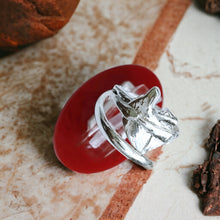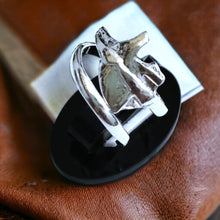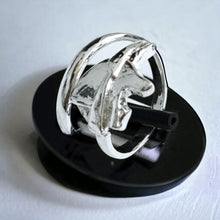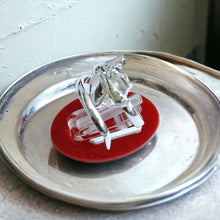
The Silver God Anubis Adjustable Ring is a modern piece of jewelry inspired by ancient Egyptian mythology. Anubis, the god of mummification and the afterlife, is depicted on this adjustable ring, symbolizing protection and guidance. Crafted in silver, this ring merges historical reverence with contemporary fashion, reflecting the enduring influence of ancient Egyptian culture in today's accessories.
- History: Ancient Egyptian deity Anubis, god of embalming and the afterlife.
- Spirituality: Symbolizes protection, guidance, and transition.
- Talisman: Carries mystical significance, believed to ward off negativity and bring blessings.
- Handmade: Crafted with care, each piece unique.
- Healing: Thought to promote mental clarity and emotional balance.
- Material: Made from sterling silver, renowned for its purity and durability.
- Symbolism: Anubis represents death and rebirth, guiding souls to the afterlife.
- How to Wear: Adjustable ring for versatility, can be worn on different fingers for personal preference and style.
History Side For Those Who Are Interested
Anubis, one of the most iconic and enduring figures in ancient Egyptian mythology, occupies a significant place in the pantheon of gods worshiped by the ancient Egyptians. As the god of mummification and the afterlife, Anubis played a crucial role in guiding souls through the perilous journey of death and ensuring their safe passage into the underworld.
The origins of Anubis are somewhat obscure, with evidence suggesting that his cult may have emerged as early as the predynastic period (c. 3100 BCE). However, it was during the Old Kingdom (c. 2686–2181 BCE) that Anubis rose to prominence as a central figure in Egyptian religious beliefs. In the Pyramid Texts, some of the oldest religious texts in the world, Anubis is already depicted as the guardian of the necropolis and the god who oversees the embalming process.
Anubis is typically depicted with the body of a man and the head of a jackal, a canid animal associated with death and the desert. This amalgamation of human and animal features reflects the ancient Egyptians' complex understanding of divinity, wherein gods often took on hybrid forms embodying various aspects of nature and the supernatural realm.
One of Anubis's most important roles was overseeing the process of mummification, a sacred and meticulously performed ritual aimed at preserving the deceased's body for the afterlife. According to myth, it was Anubis who embalmed the body of Osiris, the god of the dead, after he was murdered by his brother Set. This association with Osiris further solidified Anubis's status as a guardian and guide for the deceased.
In addition to his role in mummification, Anubis was also believed to weigh the hearts of the deceased against the feather of Ma'at, the goddess of truth and justice, in the judgment of the soul. This judgment took place in the Hall of Ma'at, where those whose hearts were found to be lighter than the feather were granted entry into the blissful afterlife, while those deemed unworthy faced eternal punishment.
Throughout ancient Egyptian history, Anubis remained a popular and enduring deity, revered by both commoners and pharaohs alike. His cult centers, such as the city of Cynopolis (modern-day El-Kom El-Ahmar), flourished, and his image adorned countless tombs and funerary objects.
With the decline of traditional Egyptian religion following the advent of Christianity in the region, worship of Anubis waned, and his once-prominent cult faded into obscurity. However, his legacy endured through the centuries, captivating the imagination of scholars, artists, and enthusiasts around the world who continue to be fascinated by the enigmatic figure of Anubis, the jackal-headed guardian of the dead.















